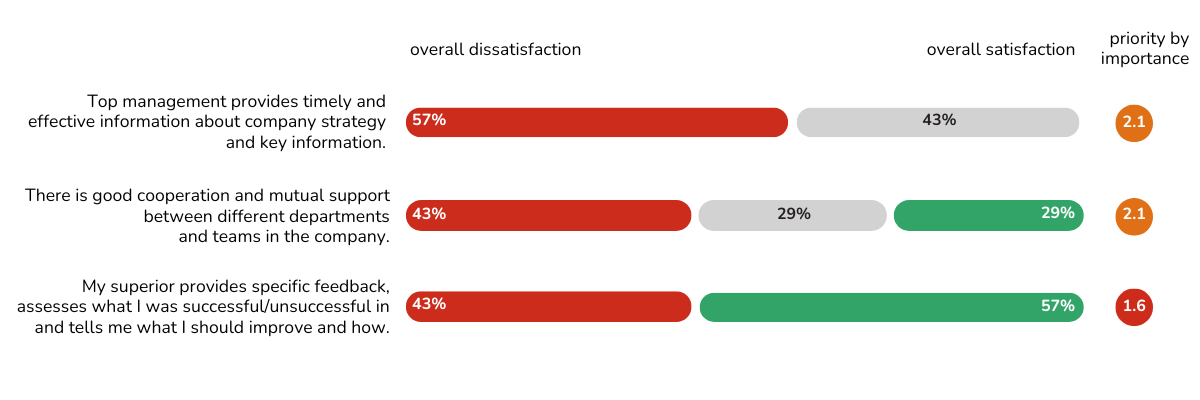Pavla Kaňková
+420 771 297 711
22. 11. 2024
Do you have the output reports from satisfaction, engagement, and loyalty surveys and are you trying to decide which numbers to include in the goals or KPIs of managers? How should you approach survey results to actually bring about improvements, and why is it not enough to simply set the numbers as goals?

When conducting employee surveys, clients repeatedly ask which numbers they should include in their goals and KPIs for managers. They seek recommendations on how to clearly define “where we want to be in a year” based on the survey outputs. The question seems simple. However, practice repeatedly shows that merely defining a specific “number” as the desired target state does not work and is insufficient.
For employee surveys, it is typical that the results of individual teams can vary significantly, even in small or medium-sized companies. Another key factor is that the results must always be perceived within the context of the specific situation and events.
For example, a company might be undergoing a challenging transformation, experiencing rapid growth, or seeing changes in teams and supervisors. All of this can either ease or complicate the work of managers and affect the results of employee surveys. Positive skewing of results can also occur simply by strengthening the team with newcomers, as newcomers tend to be traditionally more positive.
When repeating the survey and comparing results, even a slight improvement can sometimes be considered a success, while in other cases, the potential for improvement is high and desirable. In some instances, it is crucial to (if possible) maintain the existing excellent results. Therefore, don’t expect a simple and fair formula for determining which number from the employee survey to include in managers’ KPIs, because it doesn’t exist. Perhaps with one exception, which I will mention at the end.
It is usually more meaningful to define specific activities or measures in the goals and to consider scores from employee surveys as an illustration of the effectiveness of these measures. Specific steps and activities can be defined either “top-down” or can emerge from the teams themselves, i.e., “bottom-up.”
In employee surveys, it is common for certain themes to emerge that are relevant across the entire company and are worth addressing throughout the organization. Typically, this might include effective communication of strategy and vision. However, many topics are specific to particular teams or groups of employees and may not be relevant to anyone else, let alone the entire company.
To avoid being too theoretical, let’s look at a graph from the output report of an employee survey for a specific team, focusing on the questions where dissatisfaction is the strongest.

Graph: Example from the output report of the Employee Survey, source: TCC online
What should be included in the team manager’s goals in this case? Setting a goal in the form of a “score” would be very difficult, and the manager might not have the same level of influence over all areas. If we wanted to choose one area as a priority, the topic of feedback seems meaningful. The manager has the most influence in this area, and subordinates also rate this topic as important. In this area, the following steps can be set, for example:
Practice repeatedly confirms that if a manager meets all the defined sub-goals, the satisfaction level regarding feedback is very likely to significantly improve when the survey is repeated.
If you still want to include a universal number from the employee survey in your goals, it should be the response rate. The response rate indicates what percentage of employees participated in the survey. A high response rate ensures that we have feedback from the vast majority of employees, making it relevant.
And what response rate is average, good, or excellent? Again, it depends on various factors, but if we reach over 80%, that’s great. From experience, we also know that it is achievable if you know how to approach it.

29. 04. 2025
A great expert doesn’t automatically make a great leader. So, how can we reduce the risk of ruining a talented individual or a...
27. 03. 2025
Can you reliably identify great salespeople during the hiring process? What are the key traits and competencies that make a successful...